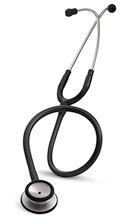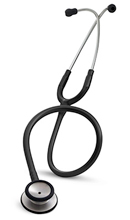STETHOSCOPE, dual head, infant (Littmann Classic II)
Valid Article
STETHOSCOPE, dual head, infant
Definition
A mechanical listening device designed for listening to sounds from the heart and/or lungs.
The chestpiece can be placed against the patient for sensing sound: a diaphragm (plastic disc) or bell (hollow cup). If the diaphragm is placed on the patient, body sounds vibrate the diaphragm, creating acoustic pressure waves which travel up the tubing to the listener's ears. If the bell is placed on the patient, the vibrations of the skin directly produce acoustic pressure waves travelling up to the listener's ears. The bell transmits low frequency sounds, while the diaphragm transmits higher frequency sounds.
The sound is transmitted from the chest piece, via air-filled hollow tubes, to the headgear into the users ears.
Specifications
Technical specifications
- Stethoscope Littmann® Classic II
- Chest piece made of stainless steel
- Traditional bell combined with 1 infant floating diaphragm (Ø 19 mm)
- Plastic single lumen tube
- flexible
- crack-restistant
- Stainless steel adjustable arms with flexible spring
- Removable tight soft-sealing eartips
- Anti-cold rim
- Total length: +/- 71 cm
Supplied with the Article
Supplied with 1 spare diaphragm and 1 spare pair of earpieces
Instructions for use
Can be cleaned and disinfected with a detergent/disinfectant solution for surfaces / non-invasive medical equipment. Prepare use-solution in concentration required. Always read the label and product information before use. Do not mix with other products. Make sure to wet the surfaces completely, use a wipe or towel, keep them wet for the whole exposure time.
Do not soak in a liquid.
Eartips can be removed from the eartubes for thorough cleaning.





![[KMEDMNUTI32] (module nut. inpatient) EQUIPMENT 2021](/web/image/product.template/575288/image_256/%5BKMEDMNUTI32%5D%20%28module%20nut.%20inpatient%29%20EQUIPMENT%202021?unique=574c48e)
![[KMEDMHDE31-] (mod delivery & neonate) MEDICAL EQUIPMENT 2021](/web/image/product.template/574359/image_256/%5BKMEDMHDE31-%5D%20%28mod%20delivery%20%26%20neonate%29%20MEDICAL%20EQUIPMENT%202021?unique=7995f43)
![[KMEDMNUTO32] (module nut. outpatient) EQUIPMENT 2021](/web/image/product.template/575293/image_256/%5BKMEDMNUTO32%5D%20%28module%20nut.%20outpatient%29%20EQUIPMENT%202021?unique=12f91c2)
![[EMEQSTET401] (Littmann Classic II) SPARE-PARTS KIT 40013](/web/image/product.template/569955/image_256/%5BEMEQSTET401%5D%20%28Littmann%20Classic%20II%29%20SPARE-PARTS%20KIT%2040013?unique=c2f5e52)
![[ETMESTET1--] TEACHING STETOSCOPE, dual head, ad/child, double headsets](/web/image/product.template/570056/image_256/%5BETMESTET1--%5D%20TEACHING%20STETOSCOPE%2C%20dual%20head%2C%20ad-child%2C%20double%20headsets?unique=342a929)